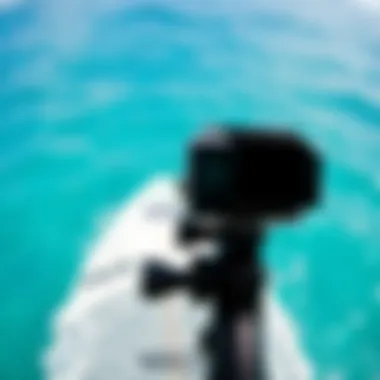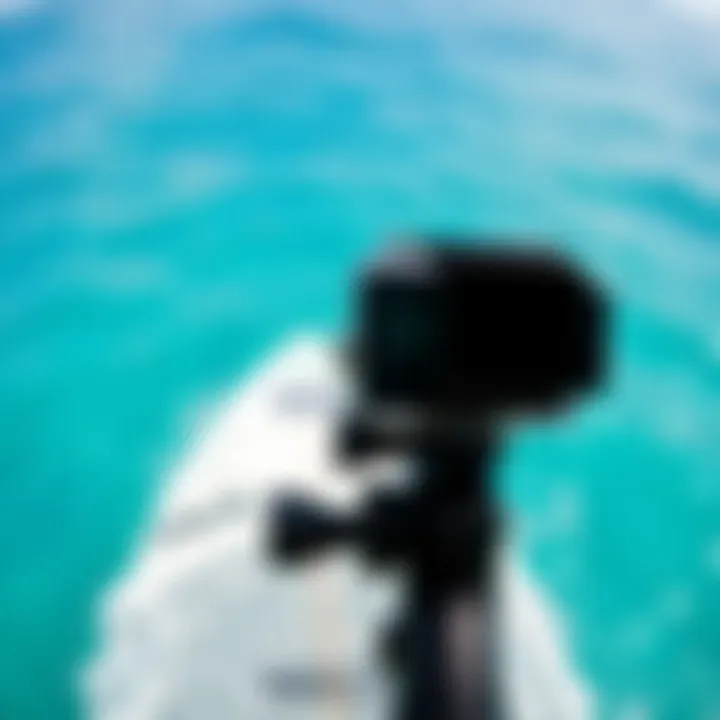Action Cameras and Gimbal Stabilizers in Watersports


Intro
In the fast-paced world of watersports, capturing high-quality footage often hinges on two essential tools: action cameras and gimbal stabilizers. Whether you're carving through waves, riding a wakeboard, or diving into the depths of the ocean, having the right equipment can mean the difference between shaky memories and breathtaking visuals. This guide will shine a light on how these devices interplay, offering insights and practical advice for enthusiasts at all levels.
The convergence of action cameras and gimbals has opened up new avenues for content creation among athletes and recreationists. You might wonder why stability matters so much. When you're engaged in extreme activities, smooth footage not just enhances the viewing experience, but it also tells a more compelling story. With the right setup, you can immerse your audience in the thrill of the ride, evoking emotions that resonate deeply.
Let’s dive deeper into this fascinating intersection in our exploration of expert insights and essential gear.
Prologue to Action Camera Gimbal Stabilizers
The harmony between action cameras and gimbal stabilizers is a game-changer for anyone seeking to document high-energy watersport activities. The use of these tools enhances the visibility and clarity of captured moments, raising the bar for video quality. In the hustle of waves and kinetic movements, having a reliable gimbal stabilizer changes how footage is perceived, making it smoother and more pleasant to watch.
Action cameras, such as the GoPro Hero series or DJI Osmo Action, are compact and rugged, ideal for capturing thrilling adventures. However, their potential can be significantly amplified through the use of gimbals like the Zhiyun Crane or FeiyuTech models, designed to keep footage steady even amidst the chaos of water splashes and rapid motion. These stabilizers work by counteracting any abrupt shakes and movements, thus ensuring that every splash, dive, and wave is portrayed beautifully.
When choosing a gimbal stabilizer, one must not just focus on cost or brand reputation but consider the specific features that align with the type of action being filmed. Not all gimbals perform equally in diverse conditions, especially on water. For instance, a stable but heavy gimbal might be challenging to maneuver while surfing, whereas a lightweight version may lack the needed stability. Balancing these factors is essential for producing videos that truly captivate audiences.
As such, this section sets the tone for understanding how gimbal stabilizers play a vital role in elevating the experience of capturing watersport adventures, addressing the nuances that need to be navigated for optimal performance. The subsequent discussions will explore the technology behind gimbals and their varied applications within the realm of watersports, ultimately guiding users in making informed decisions.
Defining Action Cameras and Gimbals
Action cameras are specialized devices tailored for versatility and portability, designed to withstand environment challenges. They have found their niche in outdoor activities where traditional cameras may struggle. Common among extreme sports enthusiasts, action cameras, like the Insta360 One R and Akaso Brave, capture high-definition video and stunning stills.
Gimbals, on the other hand, are mechanical devices that stabilize the camera by using motors and controls to make adjustments. They act as buffering against the unsteady hands of the user or external factors such as wind. The steadiness offered by a 3-axis gimbal can be compared to riding in a luxury vehicle, smoothing out the bumps of an otherwise rough journey.
In simpler terms, an action camera captures the thrill, while a gimbal ensures that the thrill’s essence is not lost in shaky footage. The synergy between the two results in visually compelling storytelling, making viewers feel as if they are experiencing these adventures first-hand.
The Importance of Stabilization in Action Footage
Stabilization is not just a nifty feature; it's a necessity when filming dynamic activities. The constant motion in watersports creates challenging conditions for capturing high-quality footage. A simple turn or a sudden wave can lead to shaky recordings, which can ruin the overall experience of a viewer.
Utilizing gimbal stabilizers minimizes unwanted motion blur, helping to create a fluid viewing experience. This ultimately means better retention of attention, and in today’s world, capturing and holding an audience's eye for just a few seconds longer can be the difference between a successful video and a skip.
Moreover, stabilized footage allows for a more profound narrative to unfold. The ability to portray extreme close-ups during a daring plunge, coupled with sweeping panoramic shots of the surroundings, fundamentally enriches the storytelling aspect of the video content. Viewers are not merely spectators—they become parts of the adventure.
“A good action shot is like a well-timed joke; it has to hit at just the right moment.”
Technical Overview of Gimbal Stabilizers
Gimbal stabilizers play a crucial role in the realm of action cameras, especially for those engaging in high-energy activities like watersports. Understanding their technical makeup can significantly enhance not only video quality but also the overall experience of creating and sharing thrilling aquatic adventures. In this section, we will break down how these devices work and explore the different types available.
How Gimbal Technology Works
Gimbal technology operates on a simple yet effective principle: maintaining a steady platform. Imagine being on a turbulent boat ride, yet your camera captures smooth footage as if you were on solid ground. This is the magic of gimbals. They utilize a combination of motors and sensors to detect and correct movements along multiple axes. By pivoting and adjusting in real-time, gimbals can counteract any unintended shifts caused by waves, swells, or sudden movements.
For instance, when you tilt your head or sway your body while riding a jet ski, the gimbal instantly compensates for these motions, keeping your action camera steady and aligned. This technology is especially beneficial for watersports, where sudden jolts and quick directional changes are commonplace. The clever design allows for capturing breathtaking shots without the nausea-inducing shakes often seen in amateur videos.
Different Types of Gimbal Stabilizers
When it comes to types of gimbals, the choice primarily hinges on the number of axes they operate on. Two main configurations stand out: two-axis and three-axis stabilizers. Each type brings its unique strengths to the table.
Two-axis Stabilizers
Two-axis stabilizers, as the name suggests, stabilize motion along two planes – typically horizontal and vertical. This type is particularly popular for its simplicity and lightweight design. These stabilizers excel at mitigating pitch and roll, which can be quite advantageous during watersport filming. However, they do not address the yaw movement, which means that while they can effectively dampen camera shake from typical movements, they may still capture some wobble during sharp turns.
Key Characteristics:
- Lightweight design, making them easy to carry
- Generally more affordable than three-axis options
Unique Features:
- Fast startup time, allowing for quick captures
- Battery-efficient, offering longer shoots without frequent charging


Advantages and Disadvantages:
- Great for general use, especially for beginner enthusiasts or those looking to keep equipment light
- However, they may leave some video footage less stable when facing extreme conditions typical in some watersport activities.
Three-axis Stabilizers
On the other hand, we have three-axis stabilizers that handle all three movements — pitch, roll, and yaw. This means that any slight movement is compensated for, allowing for smoother, more cinematic-quality footage regardless of how chaotic the conditions get.
Key Characteristics:
- Greater stabilization capabilities, tackling motion on all three axes
- Often more complex and pricier compared to two-axis stabilizers
Unique Features:
- Enhanced responsiveness to sudden changes in direction, perfect for high-velocity sports like wakeboarding or surfing
- Typically come equipped with advanced features like smartphone app connectivity for real-time adjustments
Advantages and Disadvantages:
- They are the go-to choice for serious filmmakers and watersport athletes, ensuring professional-quality videos
- However, the added weight and cost can be a downside for casual users or those who prioritize mobility over top-tier stabilization.
"The right stabilizer can mean the difference between a jumbled mess of footage and a stunning vacation film that captures every exhilarating moment with clarity."
In summary, understanding these two types of gimbal stabilizers aids in making an informed choice tailored to one's specific needs in the ever-evolving landscape of watersport filming. As you prepare to capture the water's thrill, knowing how these tools function will make a significant impact on the quality of your storytelling.
Applications in Watersports
When we talk about capturing the thrill of watersports, it's hard to overlook the role of action cameras paired with gimbal stabilizers. These pieces of tech have become indispensable tools for enthusiasts looking to document their experiences. The dynamic nature of these sports demands that both the image quality and stability be top-notch. When the waves are crashing, and you're carving turns on your board, the last thing you want to worry about is shaky footage. The following sections will take a closer look at specific applications, showcasing how gimbal stabilizers enhance the filming experience across various watersport activities.
Capturing Dynamic Action in Surfing
Surfing involves rapid movements and unpredictable waves. One moment you could be soaring high above the water, and the next, you might be crashing down. In these circumstances, video stabilization becomes key. The blend of an action camera and a gimbal stabilizer allows surf videographers to capture each twist and turn without the jarring shakes that typically accompany handheld recording.
A gimbal will offset unwanted shakes, keeping the camera level when the surfer wipes out or catches a massive wave. This stabilization ensures each ride can be relived in all its glory, showcasing not just the action but also the surrounding scenery. Practically, the lightweight nature of many gimbals means surfers can take them out without adding significant burden. For instance, a surfer using a DJI Osmo Mobile can shoot with ease, enabling them to focus more on their performance and less on the tech behind the camera.
Using Gimbals for Kayaking and Canoeing
In kayaking and canoeing, where smooth strokes through water and close encounters with nature often occur, a steady camera ensures the beauty of the experience is captured. Here, the body movement can cause a lot of vibrations. When you encounter a rapid or a gentle ripple on the surface, capturing those moments without visual distraction is crucial.
Gimbals mitigate these issues remarkably well. With devices like the Zhiyun Smooth 4, kayakers can achieve footage that encapsulates the grace of paddling through serene waters or navigating sudden soundness. This allows for a storytelling aspect that static cameras can’t capture. Imagine paddling through a misty morning, birds flapping nearby. A stable video transforms moments like these into something magical. Plus, many models are waterproof or splash-proof, ensuring they hold up against wet conditions.
Stand-Up Paddleboarding: A Unique Perspective
Stand-up paddleboarding (SUP) presents its own set of challenges and opportunities for videographers. Unlike surfing, where the action is often front-and-center, SUP often features wide perspectives, with the paddle boarder gliding over a stunning expanse of water.
For this reason, a gimbal can enrich the viewer’s experience by allowing for fluid pans and tilts, capturing both the paddler and their backdrop. The Master of SUP filming lies in harnessing that unique perspective. Gimbals like the FeiyuTech G6 are particularly beneficial since they combine lightweight design with robust stabilization features. Whether it's a leisurely paddle at sunset or tackling waves, the flexibility of shooting angles becomes a breeze. This adaptability enables the filmmaker to explore creative shots that bring depth and narrative to each video.
Choosing the Right Gimbal Stabilizer
Selecting the right gimbal stabilizer is akin to finding the right pair of boots for a hike; it can make or break your experience, especially in the exhilarating yet unpredictable world of watersports. With options aplenty, making an informed choice often boils down to understanding the nuances that suit one's specific needs. This section sheds light on crucial factors to consider, helping you navigate the sea of choices with more confidence and precision, ultimately optimizing your filming endeavors.
Factors to Consider When Selecting
Weight and Portability
When diving into the realm of action camera gimbals, weight and portability stand as top considerations. Think about it: when you’re out on a jet ski or battling the waves while surfing, the last thing you want is cumbersome equipment weighing you down. A lightweight gimbal can dramatically ease the burdens of transport and usage.
For instance, a gimbal like the DJI Osmo Mobile 3 weighs about 400 grams and folds up for compact packing. This lightweight characteristic not only enhances your mobility but also allows for spontaneous filming without any excessive fuss. However, one must be wary; lighter materials sometimes compromise stability and robustness, which are vital when filming dynamic actions. Accordingly, the sweet spot between weight and durability should guide your selection process.
Compatibility with Cameras
Another pivotal factor is compatibility with your camera of choice. Nothing is more disheartening than discovering that your prized action camera doesn’t fit snugly into your gimbal’s cradle, leaving you in a bind. Most modern gimbals accommodate various models, but ensuring that your specific camera is supported can save significant headaches down the line.
For example, the Zhiyun Weebill S boasts a versatile design which can handle a wide range of DSLR and mirrorless cameras. This flexibility allows creators to switch between equipment without needing multiple gimbals, making it a smart choice for those who value convenience. However, gimbals that offer broader compatibility might sometimes sacrifice fine-tuned controls suited for more specialized gear sales; keeping tabs on what’s most beneficial for your setup is essential.


Battery Life
In water sports, just as in life, time can fly when you're having fun, and you don’t want your battery dying halfway through an epic session! Consequently, battery life is a prime consideration. A gimbal that can keep recording for hours allows you to focus on enjoying the activity rather than constantly worrying about battery management.
The FeiyuTech AK2000C, for example, presents an impressive battery life of around 7 hours under ideal conditions. Yet, it’s essential to note that heavy usage, especially in challenging environments, may shorten this lifespan. A gimbal with a replaceable battery can enhance your freedom during long filming days, allowing you to carry extras without much hassle.
Price Range and Features
Determining the right gimbal also involves evaluating its price relative to the features it offers. Prices can vary significantly based on brand reputation, technology, build quality, and incorporated features. When investing, weigh whether the additional features—like auto-follow modes or advanced stabilization techniques—justify the cost. Sometimes, a basic model can suffice for beginners, thus curbing initial expenses, while seasoned pros might seek top-tier performance even at a higher price point.
A balanced approach can ensure you have the right tool fostering creativity and quality in documenting your watersport adventures.
Ultimately, the right gimbal stabilizer can transform your chaotic watersport sessions into smooth, cinematic experiences that are enjoyable to capture and even better to share.
Best Practices for Using Gimbal Stabilizers
Using a gimbal stabilizer can be a game changer for capturing high-quality footage during watersports. However, like any tool, its effectiveness largely depends on how you utilize it. Adhering to best practices not only helps in achieving smoother shots but can also prolong the life of your equipment. Here, we will delve into essential principles that can make a significant difference in your filming experience.
Balancing the Gimbal Correctly
Achieving the right balance on your gimbal is like finding the sweet spot on a surfboard. If it's off-kilter, you could end up with shaky footage that’s not worth viewing. Each gimbal is designed with a specific balancing method, often revolving around the center of gravity of the camera setup.
- Weight Distribution: Ensure your camera and any added accessories are evenly distributed. Ideally, you should position the camera and attachments in such a way that when you let go, they remain level.
- Locking Mechanisms: Most gimbals come with locks on the axes. Make sure they are locked when balancing and unlocked when you are ready to shoot. This prevents any mishaps during the balancing phase.
- Trial and Error: It might take a few attempts to get it just right, and that's completely normal. Just like learning to ride a wave, practice makes perfect, so take your time to adjust until it feels right.
"A well-balanced gimbal is the foundation for capturing fluid, professional-looking footage, especially in the unpredictable conditions of watersports."
By spending those crucial minutes on balancing, you set the stage for excellent results.
Adjusting Settings for Optimal Performance
Settings on your gimbal can significantly dictate the final footage quality. It is essential to adjust these settings based on the unique requirements of the activity you're filming. This fine-tuning can help extract the best performance and smoothness.
- Follow Modes: Understanding the different follow modes your gimbal offers is key. The modes allow you to dictate how the camera moves relative to your movements. For instance, the "follow mode" will keep the camera focused on an object, while "lock mode" will maintain a steady shot regardless of motion.
- Speed Settings: Adjusting the follow speed is just as important. If you're filming high-speed watersports, a quicker response may be necessary. Conversely, for slower movements, a gradual speed can enhance the footage.
- Calibration: Always recalibrate the gimbal before embarking on a new shoot, especially after changing camera settings or mounting new equipment. This step ensures all components operate in sync.
The combination of a well-balanced gimbal and the right settings can elevate your footage, creating an immersive experience that resonates with viewers. As technology evolves, staying abreast of your gimbal’s capabilities will help you remain at the forefront of quality filming.
Post-Production Techniques for Water Footage
In the realm of watersport videography, filming is just the starting line of a thrilling marathon. Once the action is captured, the real magic happens in post-production. This stage is crucial as it transforms raw footage into visually stunning narratives that do justice to the adrenaline-fueled experiences on the water. Here, we’ll dive into the nitty-gritty of this essential process, breaking down the techniques to enhance your aquatic recordings.
Editing Stabilized Footage
Editing stabilized footage is akin to polishing a diamond. It’s where you take the raw, sometimes shaky visuals from your thrilling rides and refine them into a fluid storyline. The first step in the editing process usually involves selecting the best shots. This means sifting through a sea of footage to find those heart-stopping moments that truly encapsulate the essence of the sport.
Once you have your desired clips, you'll need to cut out any extraneous frames. In watersports, this could mean skipping over scenes where the action fell flat or where the camera may have lost its balance before stabilization kicked in. Many editing software programs, like Adobe Premiere Pro or Final Cut Pro, offer stabilization tools that work wonders on that unsteady footage, keeping your video sleek and smooth.
Additionally, consider the narrative structure. Placing action-packed segments at key intervals can keep viewers engaged, while slow-motion effects can enhance the drama of a gnarly wipeout or a triumphant finish. A well-timed cut can make all the difference in converting mere video into a captivating story that resonates with an audience.
"In editing, less can be more; focus on the most impactful moments to create a stronger narrative."
Using Color Grading and Effects
After stabilizing your footage, you'll want to give it the visual flair it deserves. Enter color grading—this is where you can truly express the mood of your footage. Different shades can evoke various feelings: warmer tones may create a sense of adventure and exhilaration, while cooler tones can capture the serenity of a calm paddleboard ride.
Using software like DaVinci Resolve or Adobe Premiere's Lumetri Color, you can adjust brightness, contrast, and saturation levels. With just a few clicks, you could transform a dull day of filming into a sun-soaked escapade teeming with color and vibrancy. It's a powerful way to elevate the emotional impact of your story, making it resonate stronger with audiences.
Applying special effects can also set your footage apart from the crowd. Think about light flares on the water or a slight vignette around the edges of your video. Those little touches can inject life and personality into your recordings, capturing an audience's attention and keeping them glued to the screen.
The end game here is to create a finished piece that doesn’t merely showcase water sports but immerses viewers in an experience, one that reflects the excitement, the thrill, and the unique atmosphere of life on the water.
Common Challenges and Solutions


When venturing into the captivating world of watersports, enthusiasts often hit a few bumps along the way, particularly when it comes to capturing those exhilarating moments. This section aims to address critical challenges many encounter while using action cameras paired with gimbal stabilizers. By shining a light on these common hurdles and proposing viable solutions, the goal is to enhance both the filming experience and the final output. Understanding these challenges is essential, as it can mean the difference between a mediocre shot and a breathtaking clip that captures the essence of the sport.
Dealing with Water and Humidity
Water and humidity pose significant challenges when filming in aquatic environments. Action cameras are often designed to withstand some exposure to moisture, but the delicate mechanisms of gimbals require a bit more care. Fine droplets of water can disrupt the gimbal's motor operation, leading to unstable footage or, worse yet, damage to the equipment.
To tackle this issue:
- Invest in Waterproof Gear: Look for waterproof gimbal housings or cases that can prevent water infiltration. Companies like GoPro and DJI offer solutions that maintain functionality while keeping water at bay.
- Regular Maintenance: After each use, especially in salty or chlorinated environments, rinse off your equipment with fresh water to prevent corrosion. This simple step can extend the life of your gear considerably.
- Use Anti-Fog Inserts: Humidity can lead to condensation inside your camera and gimbal. Anti-fog inserts or desiccants can help keep the interior dry and clear.
Staying proactive about protecting gear not only improves footage quality but also gives users peace of mind while they focus on capturing the action.
Handling Unstable Conditions While Filming
Watersports are by nature unpredictable. High waves, sudden shifts in wind, and other environmental factors play a role in how stable your footage can be. Whether you are surfing, paddleboarding, or kayaking, the conditions can change rapidly, and this can heavily impact the effectiveness of your gimbal.
Here are a few strategies to mitigate instability:
- Choose the Right Stabilizer: Not all gimbals are created equal. Some are better suited for high-impact moving environments than others. Understanding which gimbal works best for your specific sport is key.
- Adjust the Damping Settings: Many gimbals come with adjustable damping settings. The right configuration can compensate for uneven surfaces, reducing the impact of sudden movements.
- Practice Maneuvering: Filming while being tossed about on the water requires skill. Take time to practice your filming techniques in a controlled setting before heading into more chaotic conditions.
Remember, even with the best gear, the unpredictable nature of watersports can add an element of excitement—and sometimes chaos—to your footage. It's essential to embrace this uncertainty but also approach it with strategies to optimize your results.
"Preparation can transform chaos into breathtaking captures that have the power to tell your adventure story."
Ultimately, addressing these challenges can drastically improve the quality of the videos you create, ensuring that when you look back on your footage, you see moments of triumph rather than frustration. Keep aiming for that perfect shot, and with the right knowledge and tools, you can surely achieve it.
Future Trends in Gimbal Stabilization
As technology continues to evolve at breakneck speed, gimbal stabilizers are no exception. They are becoming increasingly sophisticated, offering features and functionalities that were once only dreams for enthusiasts. This section delves into important trends that are shaping the future of gimbal stabilization, particularly in the context of watersports. Gimbal technology plays a vital role in ensuring fluid, stable footage during dynamic movements on water, making it essential for capturing those breathtaking moments of action. Some of the key elements to consider include advancements in technology, emerging features, and potential integrations with other gear.
Advancements in Technology and Features
In recent years, we have seen significant advancements in gimbal technology that enhance user experience and video quality. Here’s what to look out for in the coming times:
- Enhanced Sensor Technology: Newer gimbals are equipped with advanced sensors that better detect movement, allowing for quicker adjustments in stabilization. This results in smoother footage, even in choppy water conditions.
- Improved Battery Life: With longer battery life, modern gimbals can keep up with extended filming sessions, especially beneficial for adventurous spirit who may spend hours on the water.
- Compact Designs: Manufacturers are focusing on making gimbals that are lightweight and easy to carry. These compact designs enable athletes to remain agile while filming, a significant benefit in watersports.
"The future of filming in action sports hinges on how quickly and effectively our gear can respond to the unpredictable environment around us."
- Smart Features: Features like automatic subject tracking and gesture controls have made their way into gimbals, adding a layer of convenience. For instance, when surfing or paddleboarding, simply waving your hand could set your gimbal into tracking mode.
These advancements not only bolster the filming experience but allow users to push the boundaries of creativity while documenting their passions.
Potential Integrations with Other Gear
As the nature of filming evolves, the integration of gimbal stabilizers with other filming gear has become increasingly relevant. The synergy created by these integrations can lead to groundbreaking opportunities.
- Drones: Imagine flying a drone equipped with a powerful gimbal stabilizer; the result would be aerial shots that capture the action from above, enhancing storytelling in watersports videos.
- Smartphones: The rise of smartphone filmmaking has compelled gimbal creators to develop models that enhance mobile video stability. With features optimized for various devices, capturing those fishing tales becomes as easy as a swipe.
- Action Cameras: Naturally, the compatibility between gimbals and action cameras is paramount. As new action camera models hit the market, gimbals are set to adapt swiftly, providing perfect balance and stability tailored for each specific camera.
- Wearable Tech: With the emergence of smartwatches and wearable health devices, it’s conceivable that future gimbals could incorporate metrics related to performance, sharing real-time data alongside video capture. This convergence can aid in analyzing different watersport activities and performance levels.
In summary, gimbal stabilization is on the cusp of a transformation that could revolutionize how we capture watersports. These advancements provide not only better stability and film quality but also foster creativity by merging various technologies and gear. Keeping an eye on these trends can be a game-changer for both amateur and professional videographers.
End: Enhancing Your Watersport Experience
Capturing the thrill and beauty of watersports goes beyond just pointing a camera at the action. It involves understanding the subtleties of how to present those breathtaking moments effectively. In this conclusion, we’ll delve into why merging action cameras with gimbal stabilizers is essential for anyone passionate about documenting their aquatic adventures.
The Continuous Evolution of Filming Techniques
Filming techniques in the watersport arena have come a long way. We’ve seen rapid advancements in technology, but there’s more to it than just hardware improvements. Action camera gimbal stabilizers play a vital role in this evolution. They're not merely tools but extensions of the filmmaker’s vision. In an environment as unpredictable as open water, stability becomes paramount. Recent trends show an increasing integration of AI algorithms that assist in stabilization and subject tracking, allowing athletes to focus on performance while capturing high-quality footage.
Consider how filmmakers use these technologies to tell stories, not just capture events. Each shot tells where the sport meets the splendor of nature. This narrative quality turns ordinary footage into extraordinary experiences, resonating deeply with audiences. As filming techniques continue to change, they also inspire filmmakers to push boundaries and explore new creative avenues.
Encouraging Creativity in Watersport Documentation
Using action cameras and gimbal stabilizers is not just about creating stable footage; it's about igniting creativity. The potential these tools provide can lead to some of the most innovative storytelling techniques in watersports. For example, underwater shots paired with dynamic drone footage offer viewers perspectives they might have never seen, creating a compelling narrative.
For athletes and recreationalists, understanding how to use their equipment creatively adds an exhilarating layer to their documentation of the experience. Techniques can be as simple as varying camera angles or incorporating unique perspectives, such as low shots grazing the water surface. Also, utilizing slow motion to capture the nuances of a trick or technique can elevate the overall viewer experience, making every splash and carve compelling.
Remember to experiment and discover your unique style. The art of capturing watersports lies in personal expression; let the waves inspire you. Share these stories, and you might just inspire others to discover their waterborne adventures.
"An adventure is best shared through the lens of creativity."







